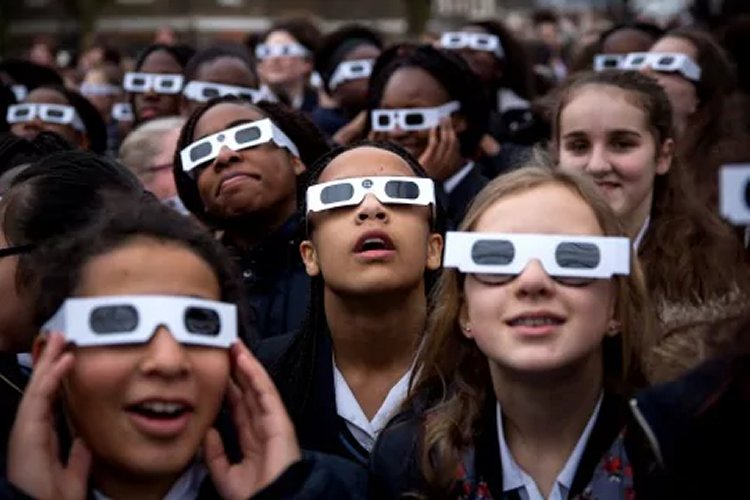Anyone who has been using online maps to decide where they intend to view the historic August 21 total eclipse of the sun may want to take another look.
Those maps, provided by NASA and others, show a crisply defined, 70-mile-wide path of totality where the moon will block 100 percent of the sun. But they are not as precise as they appear, at least on their edges.
The southern edge of the path as shown on the maps could be off by as little as the length of a football field or as much as a half-mile, eclipse mapping experts say. Likewise for the northern edge, meaning the path of totality might be just 69 miles wide.
"This is an issue. This is really an issue, but it's not advertised … Yeah, all the maps are wrong," Mike Kentrianakis, who is the solar eclipse project manager for the American Astronomical Society and who routinely consults with NASA, told the Kansas City Star.
 Students wear eclipse glasses at the Royal Observatory Greenwich during the 2015 solar eclipse in London, England. Only those who are in the path of totality can remove protective eyewear during the short period in which the moon completely blocks the sun. (Rob Stothard/Getty Images) |
It effectively means that people who assumed, based on the Google maps, that their location was just within the path of totality — thus expecting to witness a few seconds of total eclipse — will instead see a partial eclipse. That could turn out to be a total disappointment, according to eclipse experts, who say that observing even a 99.9 percent partial eclipse is not at all the same as viewing a total eclipse.
Current maps show the eclipse's southern edge cutting through downtown Kansas City, Missouri, slicing across buildings. And they do it with great precision, noting the time of total eclipse down to the tenth of a second.
But Kentrianakis, who discusses the issue as part of a new documentary, "Totality: The American Experience," said a more accurate line runs about a half-mile north.
Current maps also show the path cutting a sharp line through parts of St. Louis, Missouri.
"St. Louis also is wrong," Kentrianakis said. Indeed, the map's edges are off along the entire path from Oregon through South Carolina.
Xavier Jubier, a French engineer whose calculations have been used to create the interactive Google maps of the eclipse, confirmed by email that the actual path of the totality is slightly narrower than the 70 miles shown on current maps.
Ernest Wright, who created maps and other multimedia presentations on the eclipse for NASA, said he thought the map might be narrower by about 110 yards, slightly longer than a football field.
He also said it's possible that Kentrianakis is correct in his estimation that the path is narrower by a half-mile or more.
"He could be," Wright said.
The reason the maps are slightly off has nothing to do with mistakes, all agree. Wright explained that eclipse maps are made based on what is known about the relative sizes and positions of the moon and the sun.
"We have really good information about the orbit of the moon, the positions of the sun, the positions of the Earth. All of that is really well nailed down," Wright said. "In order to get more accuracy, we need to take into account the mountains and valleys on the moon, and the elevations on the Earth. And we're starting to do that, as well."
The size of the moon, in fact, has been measured to within a meter, and its position in the heavens has been measured to within a centimeter.
"But the last sort of uncertainty might surprise you," Wright said. "It's the size of the sun."
It's a roiling ball of gas. "It doesn't have a solid surface," he said, making its size hard to pin down.
Scientists have calculated the sun's radius at roughly 696,000 kilometers (about 432,500 miles) from edge to center, but they do not know its size with precision.
A bigger sun would make the moon's shadow, and thus the path of totality, narrower.
"You would think you could send a satellite up there, take a picture of the sun and put a ruler on the picture and decide how big the sun is," Wright said.
But it doesn't work that way. Scientists have space-based and Earth-based telescopes constantly trained on the sun. Earth-based telescopes must contend with atmospheric interference. Space-based telescopes also have limitations.
Jubier does not think the small difference will change much for the average eclipse viewer, "as usually people don't go near the edges of the eclipse path."
But for thousands of people who live near the edge, Wright with NASA and Kentrianakis with the American Astronomical Society offer this advice: Do your best to move closer toward the middle of the path of totality.
The closer one gets to the middle of the path, the longer the totality will last, up to a maximum of about 2 minutes and 40 seconds. At the edge, totality lasts less than 10 seconds.
"There are cool things to see at the edge, too," Wright said. Some astronomers argue that viewing a solar eclipse from the edge of the path of totality offers wonderful views, including a protracted view of the sun's rosy-red chromosphere, a layer of atmosphere just above its surface.
"But the big show," Wright said, "is going to be the closer you are to the center. And you don't have to drive 35 miles. You can go 10 miles and get up to a minute of totality. If you stay at the edge, you're only going to get a couple of seconds."